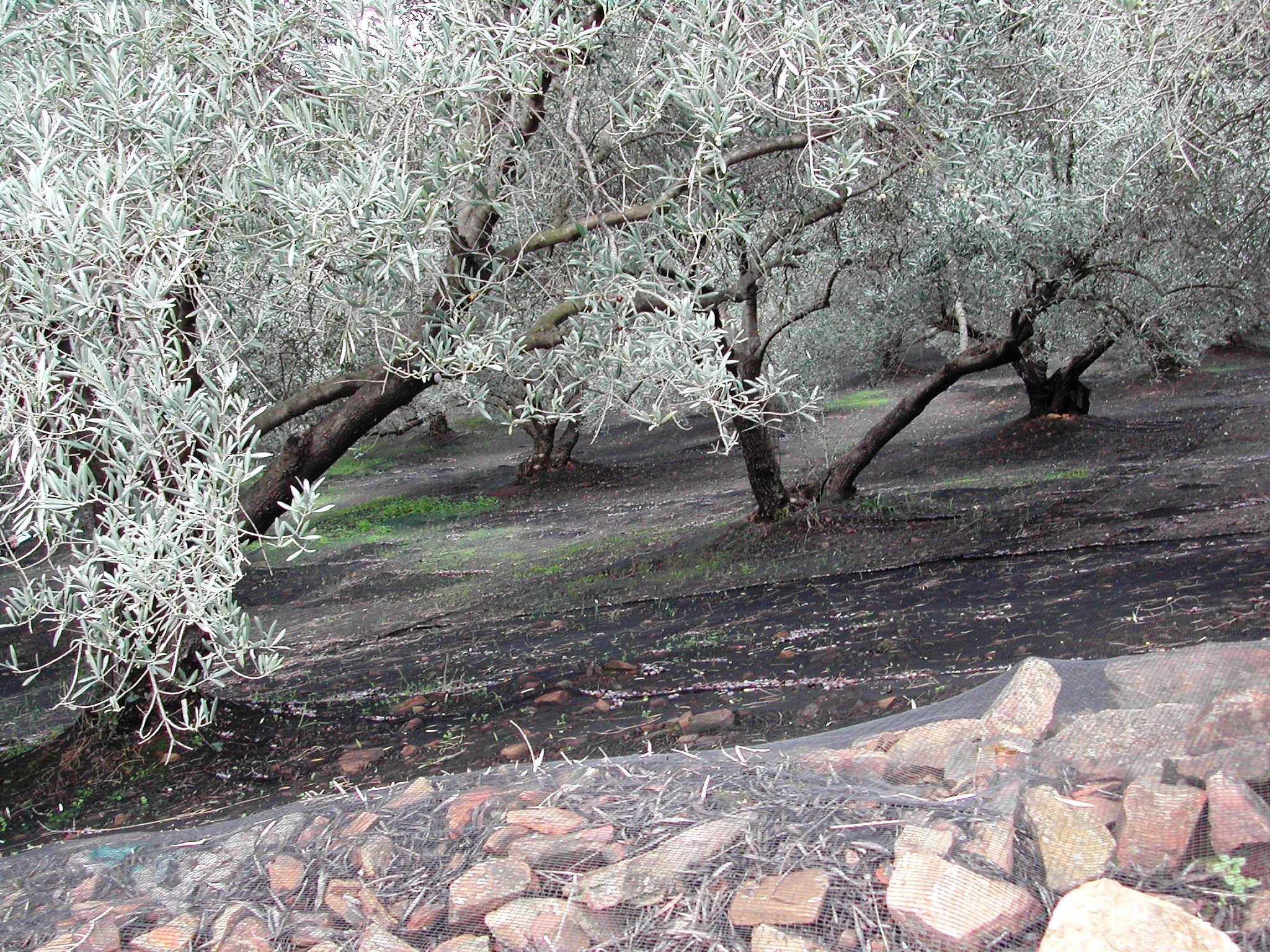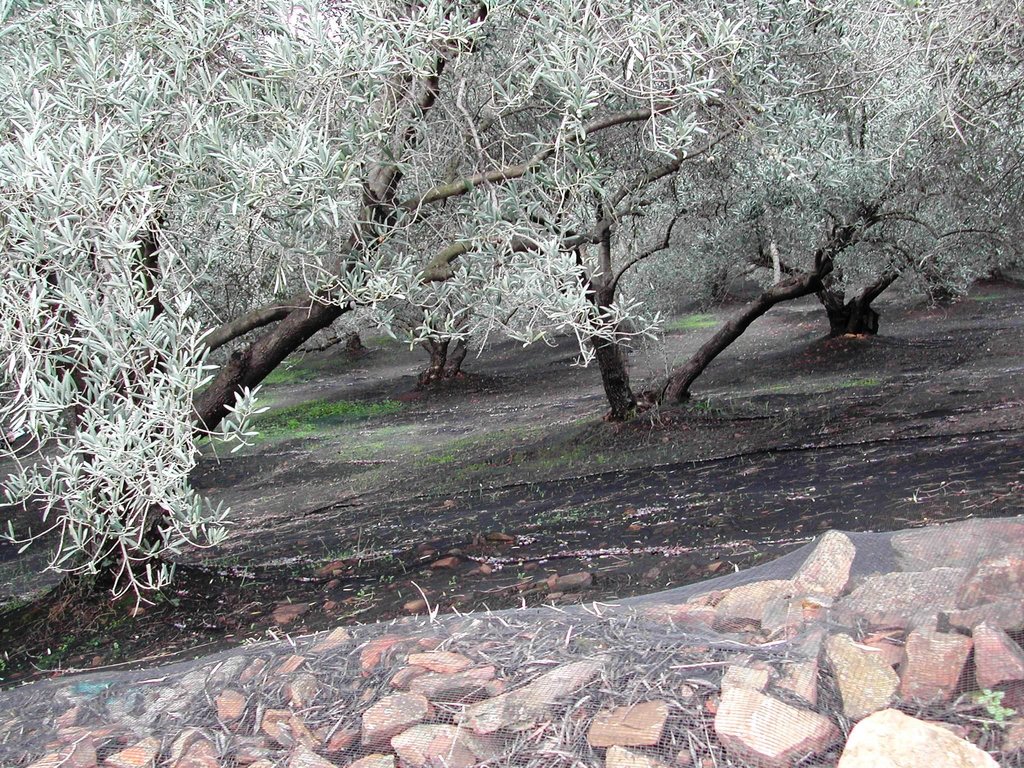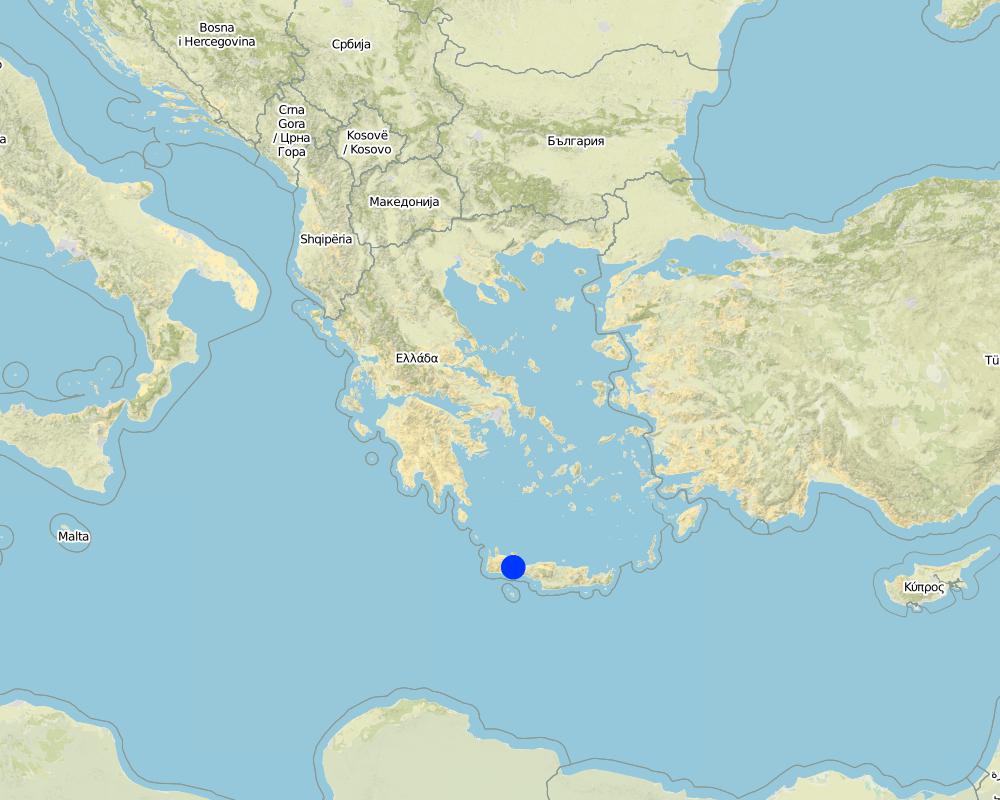No tillage operations, plastic nets permanently on the soil surface [Greece]
- Creation:
- Update:
- Compiler: Costas Kosmas
- Editor: –
- Reviewers: Fabian Ottiger, Alexandra Gavilano
Κάλυψη με πλαστικά (Greek)
technologies_1087 - Greece
View sections
Expand all Collapse all1. General information
1.2 Contact details of resource persons and institutions involved in the assessment and documentation of the Technology
SLM specialist:
Mentzidakis Ioannis
National Agricultural Research Foundation - NAGREF - Institute of Olive
Greece
Name of the institution(s) which facilitated the documentation/ evaluation of the Technology (if relevant)
Agricultural University of Athens (AUA) - GreeceName of the institution(s) which facilitated the documentation/ evaluation of the Technology (if relevant)
National Agricultural Research Foundation (NAGREF) - Greece1.3 Conditions regarding the use of data documented through WOCAT
The compiler and key resource person(s) accept the conditions regarding the use of data documented through WOCAT:
Ja
2. Description of the SLM Technology
2.1 Short description of the Technology
Definition of the Technology:
A technology which combines no tillage operations and the cover of the ground with plastic nets
2.2 Detailed description of the Technology
Description:
This technology has the same main advantages and characteristics as no tillage operation against soil erosion and water lconservation. Soil erosion is drastically reduced since soil surface is protected from raindrop splashing by the existing annual vegetation and the plastic nets. Soil water evaporation is also reduced due to the mulching provided by the plant residues and the nets. Furthermore, higher amount of rain water is infiltrating into the soil compared with other traditional LMPs. The specific technique has emerged as a need to overcome obstacles to the collection of olive fruits and protection of the nets from animals. Nets are spread in the whole field (intensive cultivation) covering completely the soil surface or part of the field (extensive cultivation), so olive fruits falling down can be periodocally collected by the farmer. Furthermore, a problem arises if nets are removed from the ground and stored. Animals, like mice, prefer to go in and make their nets by destroying them. Therefore, by keeping nets in the field during the whole year they are protected from such damages. Nets are installed in the field by stones or using metallic pins of about 15 cm long which are entered into the soil. Nets can remain in the field at least 10 years. Referring to the map showing areas undergoing tillage and non-tillage operations in the study area of Chania, it can be noted that the combined technique using cover nets is applied mainly in areas with high altitude and at a rate of approximately 15% of the no tillage area.
2.3 Photos of the Technology
2.5 Country/ region/ locations where the Technology has been applied and which are covered by this assessment
Country:
Greece
Region/ State/ Province:
Kissamos province
Further specification of location:
Chania-Crete
Comments:
Total area covered by the SLM Technology is 5 km2.
Map
×3. Classification of the SLM Technology
3.2 Current land use type(s) where the Technology is applied

Cropland
- Tree and shrub cropping
Tree and shrub cropping - Specify crops:
- olive
Specify:
Longest growing period in days: 120Longest growing period from month to month: March to JuneSecond longest growing period in days: 150Second longest growing period from month to month: March to June
Comments:
Major land use problems (compiler’s opinion): high soil erosion rates and lack of water for irrigation
Major land use problems (land users’ perception): Hig cost of olive oil production
3.4 Water supply
Comments:
Water supply: mixed rainfed - irrigated, full irrigation
3.5 SLM group to which the Technology belongs
- improved ground/ vegetation cover
- minimal soil disturbance
3.6 SLM measures comprising the Technology

agronomic measures
- A3: Soil surface treatment

management measures
- M2: Change of management/ intensity level
Comments:
Main measures: agronomic measures
Secondary measures: management measures
Type of agronomic measures: retaining more vegetation cover, mulching, manure / compost / residues, zero tillage / no-till
Type of vegetative measures: in blocks
3.7 Main types of land degradation addressed by the Technology

soil erosion by water
- Wt: loss of topsoil/ surface erosion

water degradation
- Hs: change in quantity of surface water
Comments:
Main type of degradation addressed: Wt: loss of topsoil / surface erosion
Secondary types of degradation addressed: Hs: change in quantity of surface water
Main causes of degradation: crop management (annual, perennial, tree/shrub) (soil erosion), poverty / wealth (loss in farm income)
3.8 Prevention, reduction, or restoration of land degradation
Specify the goal of the Technology with regard to land degradation:
- reduce land degradation
Comments:
Main goals: mitigation / reduction of land degradation
4. Technical specifications, implementation activities, inputs, and costs
4.1 Technical drawing of the Technology
Technical specifications (related to technical drawing):
Technical knowledge required for land users: low
Main technical functions: increase in organic matter
Secondary technical functions: increase of surface roughness
Retaining more vegetation cover
Material/ species: oxalis sp
Mulching
Material/ species: plastics
Quantity/ density: plastics a
Manure / compost / residues
Material/ species: green manure, oxalis sp
Remarks: natural growing plant
Zero tillage / no-till
Remarks: tillage is not allowed since nets will be destroyed
In blocks
Vegetative material: O : other
Number of plants per (ha): 250
Vertical interval between rows / strips / blocks (m): 5
Spacing between rows / strips / blocks (m): 5
Vertical interval within rows / strips / blocks (m): 5
Width within rows / strips / blocks (m): 4
Perennial crops species: olives
Other species: existing vegetation
4.2 General information regarding the calculation of inputs and costs
other/ national currency (specify):
Euro
If relevant, indicate exchange rate from USD to local currency (e.g. 1 USD = 79.9 Brazilian Real): 1 USD =:
1.49
Indicate average wage cost of hired labour per day:
80.00
4.3 Establishment activities
| Activity | Timing (season) | |
|---|---|---|
| 1. | Buy the nets |
4.4 Costs and inputs needed for establishment
| Specify input | Unit | Quantity | Costs per Unit | Total costs per input | % of costs borne by land users | |
|---|---|---|---|---|---|---|
| Labour | Installation | ha | 1.0 | 320.0 | 320.0 | |
| Equipment | Nets | ha | 1.0 | 2700.0 | 2700.0 | |
| Total costs for establishment of the Technology | 3020.0 | |||||
| Total costs for establishment of the Technology in USD | 2026.85 | |||||
Comments:
Duration of establishment phase: 0.1 month(s)
4.5 Maintenance/ recurrent activities
| Activity | Timing/ frequency | |
|---|---|---|
| 1. | replacing destroyed nets | 0.2 days/ha/year |
| 2. | reinstalling nets removed by winds or other reason | 0.5 days/ha/year |
4.6 Costs and inputs needed for maintenance/ recurrent activities (per year)
Comments:
Machinery/ tools: no tools
the cost has been calculated for the year 2009
4.7 Most important factors affecting the costs
Describe the most determinate factors affecting the costs:
the purchase of materials
5. Natural and human environment
5.1 Climate
Annual rainfall
- < 250 mm
- 251-500 mm
- 501-750 mm
- 751-1,000 mm
- 1,001-1,500 mm
- 1,501-2,000 mm
- 2,001-3,000 mm
- 3,001-4,000 mm
- > 4,000 mm
Specifications/ comments on rainfall:
With 6 months of dry period
Agro-climatic zone
- semi-arid
Thermal climate class: temperate
5.2 Topography
Slopes on average:
- flat (0-2%)
- gentle (3-5%)
- moderate (6-10%)
- rolling (11-15%)
- hilly (16-30%)
- steep (31-60%)
- very steep (>60%)
Landforms:
- plateau/plains
- ridges
- mountain slopes
- hill slopes
- footslopes
- valley floors
Altitudinal zone:
- 0-100 m a.s.l.
- 101-500 m a.s.l.
- 501-1,000 m a.s.l.
- 1,001-1,500 m a.s.l.
- 1,501-2,000 m a.s.l.
- 2,001-2,500 m a.s.l.
- 2,501-3,000 m a.s.l.
- 3,001-4,000 m a.s.l.
- > 4,000 m a.s.l.
5.3 Soils
Soil depth on average:
- very shallow (0-20 cm)
- shallow (21-50 cm)
- moderately deep (51-80 cm)
- deep (81-120 cm)
- very deep (> 120 cm)
Soil texture (topsoil):
- medium (loamy, silty)
Topsoil organic matter:
- high (>3%)
5.4 Water availability and quality
Ground water table:
> 50 m
Availability of surface water:
good
Comments and further specifications on water quality and quantity:
Water quality (untreated): good drinking water, for agricultural use only (irrigation)
5.5 Biodiversity
Species diversity:
- high
5.6 Characteristics of land users applying the Technology
Market orientation of production system:
- subsistence (self-supply)
- mixed (subsistence/ commercial)
Off-farm income:
- less than 10% of all income
Relative level of wealth:
- average
- rich
Individuals or groups:
- individual/ household
Level of mechanization:
- manual work
- mechanized/ motorized
Gender:
- men
Indicate other relevant characteristics of the land users:
Land users applying the Technology are mainly common / average land users
Difference in the involvement of women and men: Yes women are used to work mainly in the house
Population density: 10-50 persons/km2
Annual population growth: 1% - 2%
5% of the land users are rich.
55% of the land users are average wealthy.
5.7 Average area of land used by land users applying the Technology
- < 0.5 ha
- 0.5-1 ha
- 1-2 ha
- 2-5 ha
- 5-15 ha
- 15-50 ha
- 50-100 ha
- 100-500 ha
- 500-1,000 ha
- 1,000-10,000 ha
- > 10,000 ha
Is this considered small-, medium- or large-scale (referring to local context)?
- small-scale
Comments:
Average area of land owned or leased by land users applying the Technology: 2-5 ha, 5-15 ha, 15-50 ha
5.8 Land ownership, land use rights, and water use rights
Land ownership:
- individual, titled
Land use rights:
- communal (organized)
- individual
Water use rights:
- communal (organized)
- individual
5.9 Access to services and infrastructure
technical assistance:
- poor
- moderate
- good
markets:
- poor
- moderate
- good
financial services:
- poor
- moderate
- good
6. Impacts and concluding statements
6.1 On-site impacts the Technology has shown
Socio-economic impacts
Production
land management
Comments/ specify:
Problem if a minimum tillage LMP is applied since nets must be removed
Income and costs
farm income
Quantity before SLM:
1800 Euro/ha
Quantity after SLM:
3200 Euro/ha
workload
Socio-cultural impacts
SLM/ land degradation knowledge
Improved livelihoods and human well-being
Comments/ specify:
Increase in farmers income and reduction the off-site effects
Ecological impacts
Water cycle/ runoff
water quality
surface runoff
Soil
soil moisture
soil loss
soil crusting/ sealing
soil compaction
6.2 Off-site impacts the Technology has shown
downstream flooding
groundwater/ river pollution
6.3 Exposure and sensitivity of the Technology to gradual climate change and climate-related extremes/ disasters (as perceived by land users)
Climate-related extremes (disasters)
Climatological disasters
| How does the Technology cope with it? | |
|---|---|
| drought | not well |
Hydrological disasters
| How does the Technology cope with it? | |
|---|---|
| general (river) flood | not well |
Comments:
protection of the area from flooding or from animal passing over
6.4 Cost-benefit analysis
How do the benefits compare with the establishment costs (from land users’ perspective)?
Short-term returns:
positive
Long-term returns:
positive
How do the benefits compare with the maintenance/ recurrent costs (from land users' perspective)?
Short-term returns:
positive
Long-term returns:
positive
Comments:
Reduction of labor and protection of of harvesting materials
6.5 Adoption of the Technology
- > 50%
If available, quantify (no. of households and/ or area covered):
500
Of all those who have adopted the Technology, how many did so spontaneously, i.e. without receiving any material incentives/ payments?
- 91-100%
Comments:
10% of land user families have adopted the Technology with external material support
250 land user families have adopted the Technology with external material support
90% of land user families have adopted the Technology without any external material support
250 land user families have adopted the Technology without any external material support
There is a moderate trend towards spontaneous adoption of the Technology
6.7 Strengths/ advantages/ opportunities of the Technology
| Strengths/ advantages/ opportunities in the land user’s view |
|---|
|
Reduce cost production but create problems to the cultivation of olive groves. The major cost in olive production is labour for harvesting. By applying this technology harvesting labour is minimized to about one tenth. It can be viable at small to medium scale farms, prone to water erosion, on very steep slopes where harvesting of olive fruits by the traditional methods become very difficult. How can they be sustained / enhanced? Providing financial support |
| Strengths/ advantages/ opportunities in the compiler’s or other key resource person’s view |
|---|
|
Technologies on conserving soil and water resources and combating desertification in Crete are mainly related to land management. Olive groves can survive under adverse climatic and soil conditions supporting a significant farmer’s income under relatively low labour. Land management practices have been adopted in the area based on tradition and transfer knowledge by the local institutes and specialists. The no tillage land management practice combined with plastic nets on the soil surface can be considered as an important technique protecting the land from degradation and desertification and increasing farmer’s income. How can they be sustained / enhanced? By explaining the advantages and disadvantages of the technology to the farmers |
6.8 Weaknesses/ disadvantages/ risks of the Technology and ways of overcoming them
| Weaknesses/ disadvantages/ risks in the land user’s view | How can they be overcome? |
|---|---|
| Difficulties in removing perrenial natural vegetation and spreading the fertilizers. | applying fertilizers by the irrigation system |
| Weaknesses/ disadvantages/ risks in the compiler’s or other key resource person’s view | How can they be overcome? |
|---|---|
| Too many plastics spread around in an area. Recycling of plastics is a great problem. | no overcome |
7. References and links
7.1 Methods/ sources of information
Links and modules
Expand all Collapse allLinks
No links
Modules
No modules




